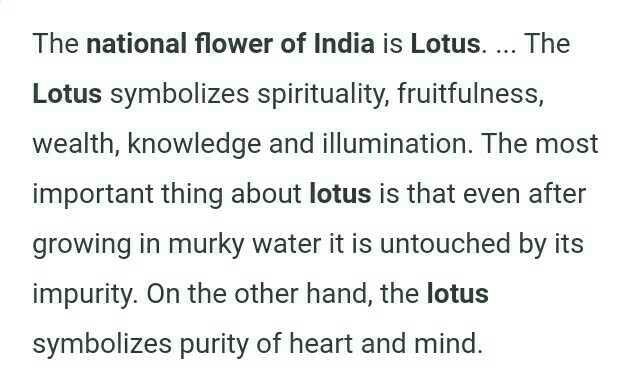Class 5 Exam > Class 5 Questions > Why Lotus is called as the national flower of...
Start Learning for Free
Why Lotus is called as the national flower of India?
Most Upvoted Answer
Why Lotus is called as the national flower of India?
Lotus, also known as Nelumbo nucifera, is considered the national flower of India. Here are the reasons why:
Religious Significance
Lotus is considered a sacred flower in Hinduism, Buddhism, and Jainism. It is believed that the lotus symbolizes purity, enlightenment, and self-regeneration. The flower is closely associated with many Hindu gods and goddesses, including Lakshmi, Saraswati, and Brahma.
Cultural Significance
Lotus has been an integral part of Indian art and culture for centuries. The flower has been depicted in paintings, sculptures, and literature. The lotus is also used in traditional medicine, where it is believed to have many health benefits.
Environmental Significance
Lotus grows in muddy waters, and its ability to rise above the water and bloom into a beautiful flower is seen as a symbol of purity and resilience. Lotus is also an important part of the ecosystem, as it provides food and shelter to many aquatic creatures.
Official Recognition
In 1950, the Indian government declared the lotus as the national flower of India. The decision was made after considering the flower's cultural and religious significance, as well as its environmental importance.
In conclusion, Lotus is considered the national flower of India due to its religious, cultural, and environmental significance, as well as its official recognition by the Indian government.
Religious Significance
Lotus is considered a sacred flower in Hinduism, Buddhism, and Jainism. It is believed that the lotus symbolizes purity, enlightenment, and self-regeneration. The flower is closely associated with many Hindu gods and goddesses, including Lakshmi, Saraswati, and Brahma.
Cultural Significance
Lotus has been an integral part of Indian art and culture for centuries. The flower has been depicted in paintings, sculptures, and literature. The lotus is also used in traditional medicine, where it is believed to have many health benefits.
Environmental Significance
Lotus grows in muddy waters, and its ability to rise above the water and bloom into a beautiful flower is seen as a symbol of purity and resilience. Lotus is also an important part of the ecosystem, as it provides food and shelter to many aquatic creatures.
Official Recognition
In 1950, the Indian government declared the lotus as the national flower of India. The decision was made after considering the flower's cultural and religious significance, as well as its environmental importance.
In conclusion, Lotus is considered the national flower of India due to its religious, cultural, and environmental significance, as well as its official recognition by the Indian government.
Community Answer
Why Lotus is called as the national flower of India?

Attention Class 5 Students!
To make sure you are not studying endlessly, EduRev has designed Class 5 study material, with Structured Courses, Videos, & Test Series. Plus get personalized analysis, doubt solving and improvement plans to achieve a great score in Class 5.

|
Explore Courses for Class 5 exam
|

|
Why Lotus is called as the national flower of India?
Question Description
Why Lotus is called as the national flower of India? for Class 5 2024 is part of Class 5 preparation. The Question and answers have been prepared according to the Class 5 exam syllabus. Information about Why Lotus is called as the national flower of India? covers all topics & solutions for Class 5 2024 Exam. Find important definitions, questions, meanings, examples, exercises and tests below for Why Lotus is called as the national flower of India?.
Why Lotus is called as the national flower of India? for Class 5 2024 is part of Class 5 preparation. The Question and answers have been prepared according to the Class 5 exam syllabus. Information about Why Lotus is called as the national flower of India? covers all topics & solutions for Class 5 2024 Exam. Find important definitions, questions, meanings, examples, exercises and tests below for Why Lotus is called as the national flower of India?.
Solutions for Why Lotus is called as the national flower of India? in English & in Hindi are available as part of our courses for Class 5.
Download more important topics, notes, lectures and mock test series for Class 5 Exam by signing up for free.
Here you can find the meaning of Why Lotus is called as the national flower of India? defined & explained in the simplest way possible. Besides giving the explanation of
Why Lotus is called as the national flower of India?, a detailed solution for Why Lotus is called as the national flower of India? has been provided alongside types of Why Lotus is called as the national flower of India? theory, EduRev gives you an
ample number of questions to practice Why Lotus is called as the national flower of India? tests, examples and also practice Class 5 tests.

|
Explore Courses for Class 5 exam
|

|
Suggested Free Tests
Signup for Free!
Signup to see your scores go up within 7 days! Learn & Practice with 1000+ FREE Notes, Videos & Tests.

























